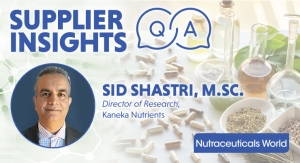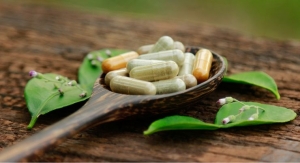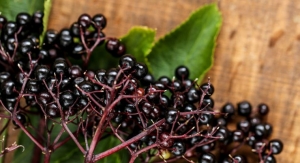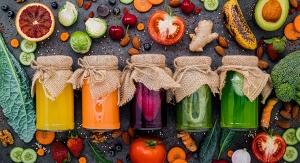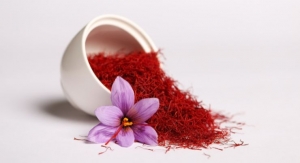Differentiation between antioxidants will be the focus for several companies going forward. Each will try to find its own niche by focusing on a particular health condition or claiming to fill the nutrient gap left by the under consumption of fruits and vegetables. In addition, the industry will continue to work diligently to resolve testing issues.
Antioxidants have Arrived
Antioxidant sales grew 6% in 2003 to $2.7 billion, according to Patrick Rea, research director, Nutrition Business Journal (NBJ), San Diego, CA. Some of the top sellers included vitamin C, vitamin E, CoQ10, vitamin A/beta-carotene, lutein, green tea and soy isoflavones (see Table 1 on page 48).
On the consumer level, Joe Marra, executive director of the Natural Marketing Institute (NMI), Harleysville, PA, says the antioxidant category registers 90% awareness among consumers, with approximately one-quarter of the population believing they are deficient in antioxidants.
By 2009, however, Dr. Bob Marshall, CEO, Premier Research Labs, Round Rock, TX, believes that nearly 100% of consumers will be able to claim awareness of antioxidants. "There is only one way this market is going to go and that is up," he said. "I think the public has figured out that antioxidants are key players in protecting the body from aging and disease."
NMI's most recent Health & Wellness Trends Report, which includes six years of trended data, indicates that consumers associate antioxidants with health issues such as cancer prevention (32%), immune support (23%) and heart health (17%). Going one step further, consumers are also beginning to associate specific ingredients with cancer prevention, including antioxidants generally (32%), green tea (20%), vitamin C (18%), garlic (17%), vitamin E (13%), soy (10%) and lycopene (9%).
Ellen Schutt, vice president, Marketing & Brand Strategy, RFI Ingredients, Blauvelt, NY, believes the high consumer awareness of antioxidants will definitely lead to an interest in more specific health conditions. "We are noticing that a lot of antioxidant products are geared toward specific health benefits (e.g., antioxidants for cholesterol lowering or skin health)," she said. "Another reason for the specificity is the confusion in the antioxidant category when comparing one antioxidant to another (e.g., green tea vs. grape seed)."
Sid Hulse marketing manager, Valensa, Eustis, FL, expressed a similar point of view. "With the exception of vitamins C and E, today most antioxidants are sold on the basis of the support they give for a particular symptom or health concern," he said. "They tend not to be sold for the general health benefits they provide across a wide range of issues."
Consumer education, however, continues to be a challenge. Gary Troxel, executive vice president, InterHealth Nutraceuticals, Benicia, CA, said, "Although the awareness of antioxidants has grown considerably over the last few years, there still remains a significant amount of confusion about why and how they work. Consumers don't yet fully grasp the issue of free radicals and the free radical scavenging accomplished by antioxidants."
Making a fruit/vegetable connection, Dr. Marshall said the antioxidant category will continue to experience growth as long as the food supply remains devoid of these types of nutrients. "In the last several years, we have seen a 50% reduction in antioxidant content of our food," he said. "The depletion of these nutrients directly correlates with the rise in disease."
Rick Kaiser, senior sales and product manager, Van Drunen Farms/FutureCeuticals, Momence, IL, agreed. "When food scientists analyzed fruits and vegetables grown in the 1950's and compared them to the same crops in 1999, they found lower levels of key nutrients like vitamin C, calcium, iron, and of course, phytochemicals," he said. "While farmers in the 1950's produced four tons of strawberries per acre, today's farmers, using fungicides and other chemicals, produce 40 tons of berries from the same land. It only makes sense that when a plant yields a 10-fold increase in fruit, the nutritive value can be compromised. These are not the same vegetables and fruits our grandparents ate."
Antioxidants could also indirectly get a boost from the recently released dietary guidelines. Mr. Kaiser said the new recommendations call for consumers to nearly double intakes of fruits and vegetables, despite the fact that three-quarters of consumers fell short of the previous ambitious goal of consuming 5-A-Day. "Eating nine to13 servings of fruits and vegetables per day on a 2000-calorie diet may present an insurmountable challenge for busy, budget-constrained families," he commented. But in most cases, a consumer problem frequently represents an industry opportunity.
| Return to top |
A Cornerstone Antioxidant Falls on Hard Times
The antioxidant category took a minor (some say major) hit last November when researchers claimed vitamin E to be harmful. To recap, a meta-analysis of 19 vitamin E studies was published in the Annals of Internal Medicine. The meta-analysis had diverse primary objectives that investigated the impact of this antioxidant on a variety of chronic diseases, including cardiovascular disease, cancer, age-related eye diseases, Parkinson's and Alzheimer's Disease. The authors conducted the analysis to look at all-cause mortality among those taking vitamin E.
Unfortunately, the conclusions were not positive, which triggered a flurry of activity among the industry trade associations and suppliers of vitamin E. Outraged by the study's conclusions, the Council for Responsible Nutrition (CRN), Washington, D.C., responded immediately commenting that the researchers inappropriately tried to draw conclusions for the whole population based on a combination of studies of people who were already at grave risk with existing diseases. "The researchers themselves noted the limitations of their meta-analysis, stating 'generalizability of the findings to healthy adults is uncertain. Precise estimation of a threshold at which risk increases is difficult.' Yet they go on to make sweeping generalizations about the use of vitamin E and all-cause mortality for the whole population," the organization said.
The vitamin E debacle also prompted CRN, along with others, to launch major initiatives backing the safety and benefits of vitamin E. Full page advertisements were taken out in major newspapers like the New York Times and USA Today. In addition, CRN became heavily involved in a variety of outreach activities with media, dietitians and pharmacists.
Coming to the rescue of vitamin E is not surprising, as it is a cornerstone ingredient in the supplement industry. Not only does it remain steadily profitable, but it is also one of the most researched antioxidants on the market. Sadly, not even vitamin E can escape controversy.
Issues like this underline the importance of safe and effective products. Frank Assumma, director of marketing, Natural Health Science, Hoboken, NJ, said antioxidants since their inception have been perceived as extremely beneficial products. But in the last six months the safety and efficacy of some of the most well known antioxidants has come into question, including vitamin E. "This is a critical issue for the industry to come to grips with because it goes right to the heart of why consumers take antioxidants," he said, adding, "If they do not feel safe about something that may not work it undermines the category's entire reason for existence."
| Return to top |
Product Development Prospects
Whether focusing on isolated constituents of sources high in antioxidants or concentrating on the whole food itself, there are many opportunities for formulators when it comes to antioxidant products. Companies are well aware of the nutrient gaps consumers face in the 21st century and are in a good position to offer solutions in the form of products that provide multiple servings of fruits and vegetables per tablet, capsule, 8-ounce beverage or 50-gram bar.
Ms. Schutt discussed the relevance of fruit/vegetable equivalency. "We advise our customers to position products as having the antioxidant equivalent of a certain amount of fruits and vegetables," she said, adding, "Rather than position a product as an antioxidant, we are advising customers to focus on another beneficial aspect of the product, like the fact that it may be equivalent to four servings of fruits and vegetables, for example."
Speaking in favor of whole foods was Thomas Payne, an industry specialist for the California Raisin Marketing Board and the U. S. Highbush Blueberry Council, based in San Mateo, CA. "Antioxidants can be delivered in several forms, but research suggests that there is a beneficial synergistic effect when the combination of phytochemicals with antioxidant activity are delivered together as in a whole food," he said.
When it comes to antioxidants variety is key, according to Ram Chaudhari, senior executive vice president and chief scientific officer, Fortitech, Schenectady, NY. "People are using several types of products to meet their antioxidant needs. But the functional food area really seems to be picking up as companies look to fortify a lot of foods with antioxidants," he said.
Speaking of foods, LycoRed Natural Products Industries, Ltd., New York, NY, recently received self-affirmed generally recognized as safe (GRAS) status for its Lyc-O-Mato powder. According to the company, GRAS status opens the door for this ingredient to be used in food fortification.
Premier Research Labs' Dr. Marshall believes antioxidants may be headed in a new direction. He says there are antioxidants that can regenerate those already existing in the blood. "This presents a simpler proposition to the public in that they will not have to deal with the alphabet soup of antioxidant ingredients and cocktails on the market," he said. "It will also lessen the burden of what consumers have to know with regard to antioxidants because they can take one particular form and know that it will help boost antioxidants already in the body."
Currently Premier is working on its newest antioxidant prospect-dihydrolipoic acid (DHLA), which is a stabilized form of the fully reduced form of lipoic acid. "This antioxidant has capabilities that lipoic acid does not have in that it can help increase the production of ATP and achieve reperfusion, which means that you can get oxygen and blood flow back to tissues that may have been damaged due to stroke or other injuries," said Dr. Marshall. "It is also very powerful in its ability to regenerate CoQ10, vitamins C and E, glutathione and NADH. It can make more efficient the body's own antioxidant factory, and do so in a very simple way."
Eric Anderson, New Business and Brand Management, PL Thomas, Morristown, NJ, offered a similar perspective. "We believe there is an opportunity to create an entirely new category of antioxidants-supplements that promote the antioxidants that our bodies produce at the cellular level, that are present in virtually all tissues and provide the first line of defense against free radicals and damage caused by oxidative stress," he said.
According to Mr. Anderson, the body's antioxidant supply can be classified into two groups: internal antioxidants and external antioxidants. "The enzymatic antioxidants, which are made by the body, include superoxide dismutase (SOD), catalase and glutathione peroxidase. They are the first and most powerful line of defense against oxidative stress," he explained. "Dietary antioxidants, which are externally provided include certain foods rich in antioxidant substances like vitamins (vitamins A, C and E), minerals (selenium, zinc, copper and manganese) and other substances like polyphenols found in grapes and green tea. These external antioxidants contribute to the antioxidant reserve, but play a secondary role to the body's own antioxidants."
| Return to top |
Antioxidant Testing & Research: Moving Beyond the Test Tube
The debate surrounding antioxidant testing has been heating up over the last few years. Currently the oxygen radical absorbance capacity (ORAC) method is the most recognized for testing antioxidant capacity, but several companies take issue with its exalted status. At this juncture, many experts believe it is time to move past in vitro testing and undertake more comprehensive human trials to assess the biological value of specific antioxidants.
Attesting to ORAC's popularity was Ron Martin, vice president of sales, Polyphenolics, a division of Canandaigua Wine Company, Granger, IN. "I think ORAC is the most widely accepted testing procedure for antioxidants," he said. "Now there is even a way to test oil soluble antioxidants, as well as water soluble antioxidants."
Speaking in favor of ORAC was RFI's Ms. Schutt, who said the testing method continues to evolve. "A brand new database of ORAC values was published last June, which has really changed the face of ORAC because there are many more fruits and vegetables to use as a point of reference," she said. "This has given industry a good base to work from and will help consumers have a better understanding of antioxidants. ORAC is the most consumer-friendly test out there."
Highlighting the importance of in vivo testing was Vladimir Badmaev, MD, PhD, vice president, Medical & Scientific Affairs, Sabinsa Corporation, Payson, UT. "A method like ORAC is valuable for the standardization of an antioxidant. However, assessing in vivo bioavailability of an antioxidant (e.g., green tea catechins or theanins improving the clinical course of a cancer, or ellagitannins of pomegranate lowering C-reactive protein levels in a cardiovascular patient) is the ultimate test," he said. "These compounds may be effective in vitro but often their efficacy in vivo is questionable."
Ronald Henson, vice president, Commercial Spirulina Sales, and Dr. Amha Belay, senior vice president and scientific director, Earthrise Nutritionals, Irvine, CA, also had some reservations about ORAC. "The unethical use of the method has resulted in consumer misinformation. Because ORAC is gaining more recognition as a method of choice, it needs to be standardized and validated, and its use for comparative purposes must be regulated somehow to provide the consumer comparison validity," they said. "Progress in nutrigenomics research is certainly going to provide more insight about nutrient and gene interaction, as well as a better measure of antioxidants and their role in disease prevention and mitigation."
Eric Anderson of PL Thomas emphasized the significance of human clinical trials to establish antioxidant effectiveness. "The most important factor in the antioxidant market will be continued interventional human trials substantiating antioxidant health benefits," he said, adding, "ORAC and TEAC and other in vitro measures of antioxidants provide a method to attempt to measure antioxidant capacity and compare antioxidant sources. However, human trials are necessary to confirm efficacy and ensure consumer health benefits, especially given the stance FDA is taking today. In this regard ORAC (as an in vitro model) has very little value."
Jan Mills, president, Artemis International, Fort Wayne, IN, says there is no problem with ORAC testing as long as it is used in context. "ORAC certainly has its place, but what always alarms me is how we embrace something so wholeheartedly without really stepping back to see what it means," she said. "First of all, there is very high variability to ORAC testing, so you can test the same material and get very high variations." Further, she says the consumer should be very skeptical when a company or trade organization says its antioxidant is the best. "To me I think this has been misleading to the consumer. We see more variation in antioxidant capacity in cultivar from blueberry to blueberry to blueberry, rather than from blueberry to pomegranate to grape seed," she explained. "Cultivar and time of harvest, all of these things make a difference in ORAC value."
There are certain situations that do call for ORAC testing, according to Ms. Mills. "When using these tests as quantitative chemical measures they are useful tools," she said. "We use ORAC as a quality control measure in order to determine batch variation, for example."
For antioxidants, however, Ms. Mills believes a complete picture of efficacy must be established. "It is nice to have a high ORAC score, but it is even better to have proof that your antioxidant has biological value. Just because a particular antioxidant has a high ORAC value does not mean that it is actually mediating a health condition," she said. "ORAC was a good first step, but a product must also show evidence of actual cell protection or other measures of biological activity in living systems. This is the more important data."
In the end, Ms. Schutt believes that ORAC is just one tool in the toolbox. "I would love to see more bioavailability work done because the use of antioxidants will only continue to grow as research reveals links to specific health issues," she said. "In 10 years we think there will be a recommended daily intake (RDI) for antioxidants on food labels. Once you can prove that a particular antioxidant is getting into the blood and benefiting a particular system(s) in the body then the government will recognize that and suggest consumers have it every day."
Scott Larkin, vice president, Sales & Marketing, LycoRed Natural Products, New York, NY, also hopes antioxidants gain more ground as the science becomes stronger. "I truly believe if consumers took more antioxidants there would be less degenerative disease," he said. "If consumers knew the story about antioxidants it would be a no-brainer when it came to supplementation."
| Return to top |
For the Future
As with most consumer markets today, specificity is fast-becoming a major priority for companies. This will impact all segments of the nutraceuticals market, including antioxidants.
Zakir Ramazanov, president, National Bioscience, Chester, NY, believes strongly that the future of antioxidants will be tied to their specific function. "We have to look deeper into the specific functionality of antioxidants, far beyond the fact that all polyphenols are antioxidants," he said. "The antioxidant market will continue its steady growth toward identification of disease/disorder specific functional antioxidants, equally as effective as pharmaceuticals, but much safer for humans."
Dr. Marshall of Premier Research Labs also thinks the future for antioxidants will be highly specialized. "There will be specific products for radiation that will protect those that work around equipment or devices that emit radiation," he said. "I also think antioxidants will become highly specialized, especially for athletes who may be exposed to certain chemicals. In fact, the Japanese are already moving in this direction."
In addressing specific population segments, Christine Peggau, global market segment manager, Dietary Supplements, Cognis Nutrition & Health, La Grange, IL, said the prevention message will be key when talking about antioxidants. "Some of the most compelling research is based on antioxidant supplements consumed over a long period of time for prevention-not to treat disease," she said. "As the population ages, there will be more demand for antioxidants as a source for overall wellness and affordable health insurance among those who want to take control over their own well-being. It will be important for this industry to focus on the 75 million aging baby boomers who will be living younger longer."
InterHealth's Mr. Troxel agreed. "Antioxidants have received a great deal of media attention in recent years because of their benefits in warding off or mitigating conditions often associated with aging," he said. "Baby Boomers, more determined than any generation before to remain young and vital, have embraced antioxidants to help in their battle against age and associated maladies."
Valensa's Mr. Hulse says antioxidants will eventually achieve a status similar to that enjoyed by the vitamins category today. "As caregivers increasingly accept the profound benefits that are available from a regular regimen of antioxidant supplementation, we can imagine a future where, much like vitamins, antioxidants are considered by the consuming public as a 'must do,'" he said. "With the mainstreaming of antioxidant supplementation, consumer product companies will look to offer a broader range of antioxidant-based products. Product differentiation will occur as a result, with a broader range of antioxidant ingredients taking part in formulations."
| Return to top |








